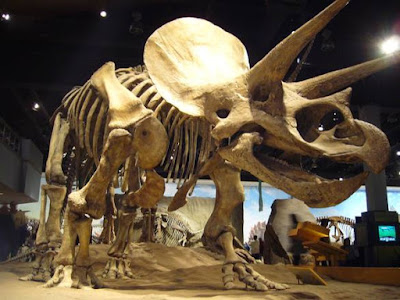Soft Tissues and Hard Facts
It's a bad time to be an advocate of microbes-to-mycologist evolution, since the facts keep undermining evolution and supporting creation. They get mighty ornery when soft tissues in dinosaurs are mentioned. Although soft tissues in the rock have been found for many years, things have really escalated with the finding tissues, blood cells, and the possibility of DNA in dinosaur remains. These things point to a young (as in recently created) Earth.
Although some evolutionary polecats will resort to presenting tall tales as scientific facts in museums for propaganda purposes, all they can do with the soft tissue thing is make lame excuses and give outrageous extrapolations. You know, iron preserved this sample for a spell, so it must have been so for 65 million years. That's not science, old son, that's desperation.
So, how do we test this stuff? How long can something last? Darwinists have challenged biblical creationists by saying something like, "Well, since the stuff deteriorates, you have a problem with it lasting the 4,000 years since Noah's Ark. Aha! I've got you!" No, you haven't. It turns out that some tests have been done to simulate great amounts of time and conditions. Fascinating stuff.
 |
| Image credit: Freeimages / Cam Campbell |
So, how do we test this stuff? How long can something last? Darwinists have challenged biblical creationists by saying something like, "Well, since the stuff deteriorates, you have a problem with it lasting the 4,000 years since Noah's Ark. Aha! I've got you!" No, you haven't. It turns out that some tests have been done to simulate great amounts of time and conditions. Fascinating stuff.
Hardly a month passes without new reports of “soft tissue” discovered in fossils. Could this material last millions of years? We need to see what laboratory studies show us about tissue decay.Firm up your resolve and finish reading the article by clicking on "Solid Answers on Soft Tissue". While you're at it, I suggest you see "More Examples of Exceptional Preservation in Fossil Reptiles".
Just last year, I visited the Carnegie Museum of Natural History in Pittsburgh. As I entered the fossil section, I didn’t know whether to laugh or lament when I read a sign that said, “Fossils that are traces of prehistoric life have no original organic parts preserved.” Such mistaken statements appear throughout popular science media, so it’s no wonder few scientists know about or accept evidence of original tissues in fossils, and even fewer are looking for new evidence.
Of course, if fossils are traces of life that lived a million or more years ago, then we have no reason to believe original organic molecules should be preserved, let alone cells or whole tissues like blood vessels. But many fossils do have these stunning features.
Dr. Mary Schweitzer and her team caught the world’s attention with a Science paper in 2005 that described intact blood vessels and red blood cells in a T. rex bone. But in fact, secular scientists have been reporting them for decades in sometimes seldom-read technical literature. That museum placard is 100 percent wrong, and every Christian should understand why.